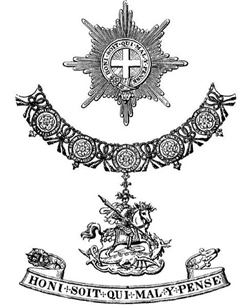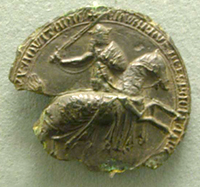King Edward III - Part 3
 In 1344, Edward held a round table tournament at Windsor taking a solemn vow to form an order of Arthurian knights. The Most Noble Order of the Garter, which consisted of 26 knights - the King and the Prince of Wales each with 12 companions was formed on the 24th of June 1348. St George was the Order's patron saint. Left: The insignia of a knight of the Order of the Garter
In 1344, Edward held a round table tournament at Windsor taking a solemn vow to form an order of Arthurian knights. The Most Noble Order of the Garter, which consisted of 26 knights - the King and the Prince of Wales each with 12 companions was formed on the 24th of June 1348. St George was the Order's patron saint. Left: The insignia of a knight of the Order of the Garter
The Black Death - a Europe-wide pandemic of bubonic and pneumonic plague - arrived in England in 1348; it soon claimed many victims including the king's favourite daughter, Princess Joan as well as between 30 and 50% of the population of Britain. In the living conditions prevalent in medieval times, it spread rapidly and mercilessly, first appearing in Britain in the west country where it devastated Bristol. It hit London in September 1348 and then moved into East Anglia, Wales and the Midlands in 1349. It reached Scotland in 1350. It is said that so rapid was the spread of the plague that the living were scarcely able to bury the dead. As a result of the plague, there was a drastic scarcity of labour and the survivors were in a position to charge more for their labours. This led to severe wage inflation. Attempts to control the situation included the Statute of Labourers Act of 1351 which made it illegal to pay wages higher than those of 1346. However these measures were not wholly successful and for some of the peasant classes, the Black Death improved their lot owing to the fact that land was cheap enabling them to increase their holdings.
 At around the same time as the battle of Crécy in 1346, Queen Philippa was fighting independently in the North of England and also using longbowmen to defeat the invading Scots at the battle of Neville's Cross - now in County Durham. Knowing that the English army was in France, David II of Scotland had invaded England. After pillaging much of Northern England the Scots were met at Nevilles Cross by an army of Lancastrians, Yorkshiremen and Cumbrians led by the Archbishop of York. The Scots were defeated by the smaller English army and David II was captured. He was to be held captive for 11 years. David was eventually released under the Treaty of Berwick which was signed on 6 November 1357. Under this Treaty, the Scots promised to pay a ransom of 100,000 marks for their king and at the same time, a 10 year truce was agreed between the English and the Scottish. Right: The Great Seal of Edward III
At around the same time as the battle of Crécy in 1346, Queen Philippa was fighting independently in the North of England and also using longbowmen to defeat the invading Scots at the battle of Neville's Cross - now in County Durham. Knowing that the English army was in France, David II of Scotland had invaded England. After pillaging much of Northern England the Scots were met at Nevilles Cross by an army of Lancastrians, Yorkshiremen and Cumbrians led by the Archbishop of York. The Scots were defeated by the smaller English army and David II was captured. He was to be held captive for 11 years. David was eventually released under the Treaty of Berwick which was signed on 6 November 1357. Under this Treaty, the Scots promised to pay a ransom of 100,000 marks for their king and at the same time, a 10 year truce was agreed between the English and the Scottish. Right: The Great Seal of Edward III
During the final years of his reign, Edward seemed to lose his grip on the country and became less and less popular with the people. The death of his wife Queen Philippa to whom he had been married for 40 years, allowed Edwards ambitious mistress Alice Perrers to wield her malign influence. She was eventually banished in 1376 by the 'Good Parliament' which was set up to moderate the growing Royal corruption. However the rivalry between the Black Prince and another of Edward's sons: John of Gaunt caused political unrest and by the time the Black Prince died on 8 June 1376, Parliament recognised the King's 10 year old grandson Richard, son of the Black Prince, as heir to the throne.
Edward III died on 21 June 1377 at Sheen Palace in Surrey at the age of 64. He had mainly been deserted by his family and had suffered from various conditions including priapism, (a persistent, usually painful, erection that lasts for more than four hours and occurs without sexual stimulation.) shingles as well as serious arterial trouble. A terminal stroke was the eventual cause of his death but it is said that before he died, Alice Perrers stripped the rings from his fingers before leaving him. A priest who later found him heard his last words: 'Misereri Jesu'. During his lifetime, Edward had won many battles but had only three castles left to show for them. He had rebuilt Windsor Castle and with his institution of the 'Order of the Garter', he had recreated the legendary feats of King Arthur's Circle of the Round Table.


